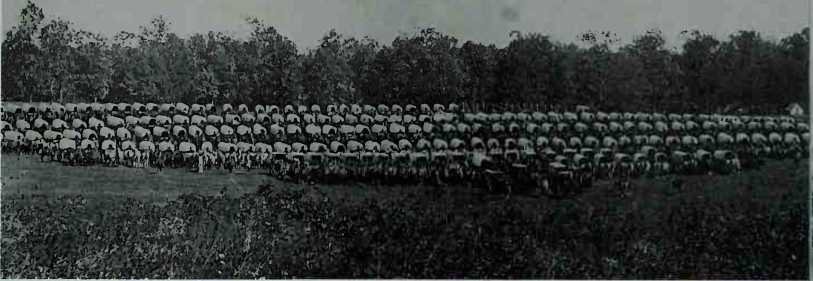Bull Run McClellan kept asking
President Lincoln for massive reinforcements before facing Lee again. But the president was determined not to leave Washington, D. C., unguarded. Instead of sending more troops south to the cautious McClellan, he created a new army of 45,000, the Army of Virginia. The new commander. General John Pope, was a somewhat skilled officer but believed he was even better. Pope quickly marched south from Manassas, aiming to destroy Richmond's supply lines.
Cedar Mountain. Robert E. Lee was determined to keep the Yankees out of his homeland of northern Virginia. Pope “must be suppressed,” he told his staff. With one eye on McClellan, Lee sent Stonewall Jackson with
12,000 men to block Pope's advance. Jackson, being Jackson, was anxious to attack, but the Yankees struck first. At Cedar Mountain 8,000 Union troops sent Jackson’s left flank reeling back in confusion. But Stonewall rallied his men, personally leading them in a counterattack that drove the Federals from the field. It was clearly Jackson’s victory, but the fighting tipped off Pope that he’d stuck his neck out too far. Before Lee could trap him, the Union general retreated skillfully north across the Rapidan River.
Jackson Becomes the Bait. Lincoln was worried about
Pope's exposed army. He ordered the Army of the Potomac back north to help. McClellan, though, was jealous of Pope’s command and was in no hurry to rush to his aid. Lee sensed a chance to smash Pope before McClellan could arrive. With General James Longstreet and the rest of the Rebel army, he rushed to join Jackson.
On August 25, 1862, Lee sent Jackson circling to Pope’s rear, aiming to cut him off. Despite the summer heat, Jackson’s “foot cavalry” marched fifty-four miles in two days. Dead tired and covered with dust, they arrived squarely behind the Yankees. Jackson captured Pope’s supply dump, even bagging the Union general’s dress uniform.
The real treat for the Rebel soldiers, however, was all the food. For a whole day, Jackson let his weary soldiers feast on the mountains of provisions—canned peaches, fine wines, lobster salad. His refreshed troops grabbed all they could carry, including pairs of new shoes, then marched away with bulging haversacks.
Pope, though surprised, thought he could still trap and destroy Jackson. He ordered his army north to Manassas to surround Stonewall’s three small divisions. When the Federals converged on the smoking ruins of their depot, though, the Rebels were gone. Stonewall Jackson had vanished, hiding his army in a nearby woods.
The Fox Turns. Pope couldn’t find Jackson, but he was sure the Confederates were fleeing, trying to rejoin Lee’s army. In fact, Jackson was doing anything but retreating. Knowing that Lee would join him the next day. Stonewall no longer needed to hide. Near sunset on August 28, Jackson moved to attack, ambushing a Yankee division near Brawner Farm. The Yankees, though outnumbered three to one, refused to run. These Union troops were just as brave as Jackson’s men.
For the next hour and a half, the two battle lines slugged it out, firing into each other from a distance of
When Union forces abandoned the Norfolk, Virginia, navai base in 1861, they burned and sank their powerful wooden warship, the USS Merrimack. Confederate Navy Secretary Stephen Maiiory saw an opportunity. He had the ship raised and refitted as a ten-gun iron-ciad, and rechristened her the CSS Virginia. The ship had a slanting fortress on its deck, it was wrapped in sheet iron so thick it couid defiect the iargest navai cannon shelis. The
Virginia soon made her name at sea. She rammed and sank the USS Cumberland, burned and sank the USS Congress, and forced the USS Minnesota aground.
The Virginia pianned to finish off the Minnesota the next day. But the foiiowing morning, a surprise awaited the Confederate ship. Standing by the crippied Minnesota was a strange, fiat-decked vessei with a round turret amidships, it was the USS Monitor, a new Union ironciad. Buiit in just four months, the /Won/for housed two powerfui cannons in her rotating iron turret.
The Monitorms nimbier and used her turret guns to hit the Virginia at wili. But she couid oniy crack, not pierce, the Rebei warship’s thick armor. One iucky shot from the Virginia, however, struck the Monitor's piiothouse. The expiosion biinded the Monitor's captain, but the ship continued to fight. The “cheesebox on a raft” fought the Virginia to a draw.
O

A wagon park at Brandy Station, Virginia. Supplying their huge armies ;i'05 the first order of battle for North and South.
No more than seventy-five yards. The impact of this concentrated rifle fire was terrible. One Confederate private, fighting behind an old fence, remembered the wooden rails splintering into fragments. Men, more fragile than wood, were knocked out of line by the dozens. Still the sui-vivors continued to stand and fire into the clouds of flickering battle smoke. The fight sputtered out in the darkness, neither side gaining the upper hand.
“Some w ere struck in the act of eating. One poor fellow' still held a potato in his grasp. ”
—A nurse at Cedar Mountain
Second Bull Run. Next morning. Pope threw his arriving troops across fields and wooded lots on the old Bull Run battlefield, certain of catching Jackson’s "retreating” men. Far from running, the Rebels were actually ready and waiting, crouching behind an unfinished railroad bed nearly two miles long. Pope foolishly attacked one brigade at a time. His tactics did nothing but waste brave soldiers against stiff Rebel defenses, even though, at points, the Yankees did manage to punch through.
In the heat of the afternoon Lee arrived with Longstreet’s men. While Jackson hung on, Lee told Longstreet to get ready for a counterpunch on Jackson’s right flank. The next day, August 30, still believing that Jackson was pulling out. Pope attacked Stonewall’s lines again, unaware of what Lee had in store.
When the Confederates opened fire on one charging Union column, the first line of Federal soldiers "looked as if it had been struck by a blast from a tempest.” One Union soldier remembered the slope being "swept by a hurricane of death, and each minute seemed twenty hours long.”
Rebel Tidal Wave. At 4 p. m. on August 30, Uee unleashed Longstreet’s 30,000 fresh men against Pope’s weak left flank. A Union private remembered the sound of the bullets as a “continual hiss and sluck," the last sound telling that the bullet had gone into some man’s body. The 5th New York Regiment was virtually wiped out—the fleeing survivors shot down as they ran into the ravine of a little creek called Young’s Branch.
One Rebel private later wrote: "Young’s Branch ran blood. The Federals completely dammed it up with their dead and dying bodies.”
The Confederate success brought such disorder among the attacking brigades and divisions that Longstreet had to pause to regroup. Pope managed to hold off Jackson’s attack on his right, while shifting men to the left for a last-ditch defense on Henry House Hill. As darkness fell, a patched-together Yankee line on the hillcrest turned back Lee’s final attack.
Pope retreated toward Washington, lucky to ha’e escaped at all. His army’s losses were almost 16,000, including more than 4,000 taken prisoner. The Rebels had lost fewer than 10,000. Lee had left the sluggish McClellan behind and whirled north, thoroughly trouncing Pope. With two victories under his belt, Lee decided to cany’ the war into the North, across the Potomac.
O
Robert E. Lee was
Mmm/




 World History
World History









